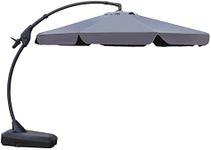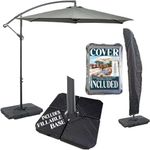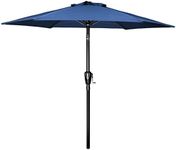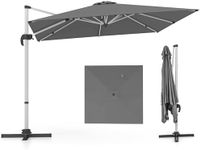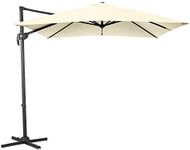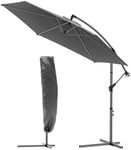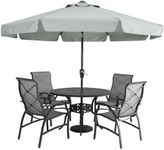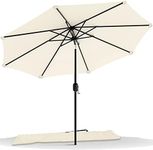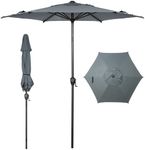Buying Guide for the Best Patio Umbrellas
Choosing the right patio umbrella can significantly enhance your outdoor experience by providing shade and comfort. When selecting a patio umbrella, it's important to consider various factors such as size, material, and functionality to ensure it meets your needs. Here are some key specifications to help you make an informed decision.SizeThe size of the patio umbrella is crucial as it determines the amount of shade it can provide. Umbrellas typically range from 6 to 13 feet in diameter. Smaller umbrellas (6-8 feet) are suitable for compact spaces or small tables, while medium-sized umbrellas (9-11 feet) are ideal for larger tables or moderate spaces. Larger umbrellas (12-13 feet) are perfect for expansive areas or multiple seating arrangements. Consider the size of your outdoor space and the area you want to shade when choosing the umbrella size.
MaterialThe material of the umbrella canopy and frame affects its durability and appearance. Canopies are usually made from polyester, olefin, or acrylic. Polyester is affordable and offers decent durability, olefin is more resistant to fading and mildew, and acrylic is highly durable and resistant to UV rays. Frames are typically made from aluminum, wood, or fiberglass. Aluminum is lightweight and rust-resistant, wood offers a classic look but requires maintenance, and fiberglass is strong and flexible. Choose materials based on your climate, aesthetic preference, and maintenance willingness.
Tilt MechanismThe tilt mechanism allows you to adjust the angle of the umbrella to block the sun as it moves throughout the day. There are several types of tilt mechanisms, including push-button, crank, and collar tilt. Push-button tilt is simple and easy to use, crank tilt offers more precise control, and collar tilt allows for 360-degree rotation. Consider how often you will need to adjust the umbrella and choose a mechanism that offers the convenience and flexibility you need.
BaseThe base of the patio umbrella is essential for stability and safety. Bases come in various weights and materials, such as plastic, metal, or concrete. Lighter bases (20-30 pounds) are suitable for smaller umbrellas and less windy areas, while heavier bases (50-100 pounds) are necessary for larger umbrellas and windier conditions. Ensure the base is compatible with the umbrella pole diameter and provides adequate support to prevent tipping.
UV ProtectionUV protection is important to shield you from harmful ultraviolet rays while enjoying your outdoor space. Umbrella canopies are rated for their UV protection, often indicated by a UPF (Ultraviolet Protection Factor) rating. A higher UPF rating means better protection, with UPF 50+ offering excellent protection. If you spend a lot of time outdoors, especially during peak sun hours, prioritize umbrellas with high UV protection to ensure your safety and comfort.
Wind ResistanceWind resistance is a key factor to consider, especially if you live in a windy area. Some umbrellas are designed with vented canopies that allow wind to pass through, reducing the risk of the umbrella tipping over. Additionally, sturdy frames made from materials like fiberglass can withstand stronger winds. If your outdoor space is prone to gusty conditions, look for umbrellas specifically designed to handle wind.
Style and DesignThe style and design of the patio umbrella can enhance the overall aesthetic of your outdoor space. Umbrellas come in various shapes, such as round, square, and rectangular, and a wide range of colors and patterns. Consider the existing decor and color scheme of your patio when selecting an umbrella. Choose a design that complements your outdoor furniture and reflects your personal style to create a cohesive and inviting atmosphere.
